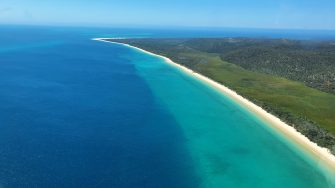
Date: Monday, November 2, 2020
Project: Eastern Australian Waterbird Survey
Observers: Richard Kingsford UNSW, John Porter UNSW/DPIE
Pilot: James Barkell NSW National Parks & Wildlife Service (DPIE)
The skies were overcast and threatening as we departed Sydney and flew north along coastal NSW, en route to our Queensland survey leg. This part of the survey is normally the first on our schedule but, because of COVID and border crossing requirements, we had to start a month later than previous years.
First up was survey band 4, the Myall River and the large estuarine lakes of the Myall Lakes system; they have large expanses of open water and rarely support large numbers of waterbirds. We found lower than average numbers of birds this year, with just a few black swans, pelicans, silver gulls and cormorants. We then flew to Port Macquarie to refuel.
Counting under grey skies over Myall Lakes
Counting along the Myall River
After refuelling we continued north toward survey band 5, where we counted small coastal lagoons and wetlands near Nambucca and Urunga, which usually have only low numbers of birds. Once again we found very low numbers of birds. The weather started to deteriorate and slow our progress with rain, low cloud and gusty winds but we managed to find a safe passage through, before flying 200 km north to survey band 6, just north of Byron Bay. There were only a few small wetlands to cover in this section and we again find very few waterbirds.
Turquoise waters around Stradbroke Island
From survey band 6, we continued our progress northwards, finally leaving the rain squalls and flying around the giant sand masses of Stradbroke and Moreton Islands, before stopping at Maroochydore for the evening. As we disembarked, we were greeted by two officers of the Queensland Police force who carefully check our border passes and permit documents were all in order.
Queensland Police carefully check our border documents
Blog by John Porter
